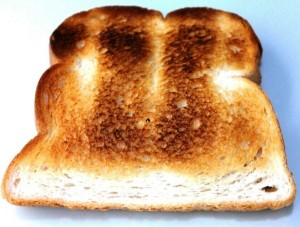Socially Acceptable
 “Right, so you’re a food blogger writing about food bloggers writing about food? Well, er yes, but hear me out…” is how the conversation might have gone if I’d given Russell the opportunity to comment on this piece. But I didn’t. Thankfully, he’s far too busy doing real foodie stuff, so publish and be damned, I say.
“Right, so you’re a food blogger writing about food bloggers writing about food? Well, er yes, but hear me out…” is how the conversation might have gone if I’d given Russell the opportunity to comment on this piece. But I didn’t. Thankfully, he’s far too busy doing real foodie stuff, so publish and be damned, I say.
I’ve been blogging about food for a little over four years now. If you’ve ever read the Well Seasoned blog you’ll know the story of our business, so I won’t repeat it here, but suffice to say that the ability to publish updates to our audience in an instant gave us a freedom that previous generations of entrepreneurs never enjoyed. Being able to tell our story, in near-real-time, and share the ups and downs of launching a food start-up, was a truly exciting and liberating experience.
Blogs, and social media generally, have democratised writing across the globe and in no sector is this truer than food. Once the preserve of a handful of lofty newspaper critics, food writing is now for everyone and, with the advent of sites like Tripadvisor and Squaremeal, everyone is a critic – literally. The internet is awash with people writing about ingredients, restaurants and cooking. Anyone with access to a computer can be published worldwide and for free – no need for a pre-existing audience or any demand for your work. Build it and they will come (provided you have the right Search Engine Optimisation).
The problem is that this democracy comes at a price. Critical oversight and quality control are the innocent victims of this bloodless (if you discount the black pudding) revolution. With so many authors churning out text and pictures, it can be difficult, if not impossible, to find the good stuff.
Is anyone really interested in seeing a dimly lit, out of focus shot of your breakfast, with optional inane caption, such as “Mmmm!” or its brother-in-bore “Yummm!!!” (the number of exclamation marks usually being directly and inversely proportional to the quality of photo)? And yet social media allows you to spew it onto the net without any check on quality and certainly without the benefit of a watchful publisher saying, “Umm, are we sure we want to go with “scrummy” as an adjective again?”
We all crave affirmation – it is part of the human condition – but social media brings out the worst in us. Anyone who publishes a blog, has a Twitter account or a Facebook page will know (whether they admit it or not) the sense of satisfaction when a tweet is retweeted, a post Liked or a blog comment received, and it’s all too easy for our writing to descend into a quest for those validations.
That’s why a poor quality picture of eggs benedict and glib accompanying caption have become the all-too-common mark of the foodie affirmation junkie. It has the highest reward-to-effort ratio: Click/apply Instagram filter/Yummm!! = 5 undiscerning ‘Likes’. It’s the quick fix, high-sugar, low-carb snack of the social media world.
So, what’s the alternative to this blogosphere junk food? Naturally, it’s fine dining; well written, descriptive prose accompanied by high quality photography and recipe writing. If you post a shonky picture of your cherry cheesecake with the caption “I LOVE cherries!”, I might give it a passing ogle but I definitely won’t respect it in the morning. But write about why cherries are the taste of summer for you, of childhood memories and hazy, long evenings, and accompany it with a well-composed evocative photograph, then not only will I Like your post, I’ll check back tomorrow to see if you’ve written another one. As the saying goes, “Give a man a fish recipe and he will feed himself. Give him a structured blog piece about how you caught that fish, what it smelled, looked and tasted like, and you feed his timeline for a lifetime (or his morning commute, whichever is shorter)“.
It’s a well-known (if not actually scientifically-tested) fact that 90% of cookbooks are never used and 90% of people who watch Jamie, Delia and Hugh cooking their way round Britain never actually make a damn thing they see. We like reading them and watching them and convincing ourselves we could live like them if we wanted, but we really don’t have time tonight so let’s just order a pizza. The same goes for blogs and social media feeds – the good ones sell an entire lifestyle, not just a snapshot. To me, food means very little unless I know its connections – Where did it come from? Who grew it? How did it end up on your plate? I want you tell me how you yearned for that dry spring day to forage elderflowers, how you enjoyed that fresh mackerel barbecued on the beach just as the midsummer sun set, or how your toddler wiped his bogies on the chocolate cake minutes before you served it to the vicar. It’s all part of the story and for social media to be interesting, the story is a vital ingredient – yet so often absent.
So, now time to put my elderberry-stained hands up – I’m acutely conscious that I need to heed my own advice here. I’m as guilty as anyone when it comes to amateurish efforts, poor photography and attention seeking. But I do try, and I do think we owe it to ourselves, as writers (of all kinds, whether professional, amateur, virtual or in print), to be the best we can in the time we have available. Before we next hit that “Publish”, “Tweet” or “Post” button, catapulting our latest musings into foodie cyberspace for the world to read, let’s make sure we’ve given it our best shot.
Oh, I nearly forgot. Here’s a picture of my breakfast. Yummm!!!!!

